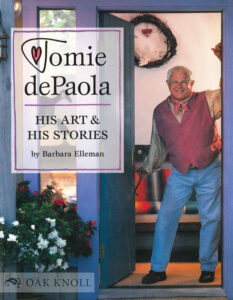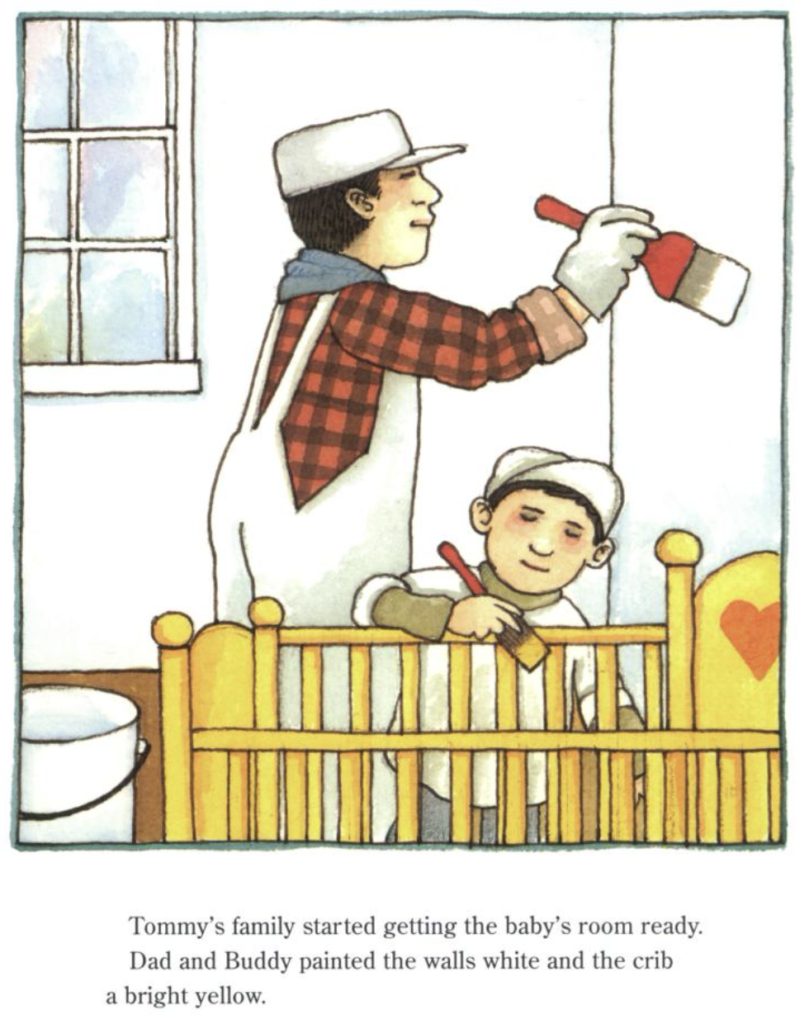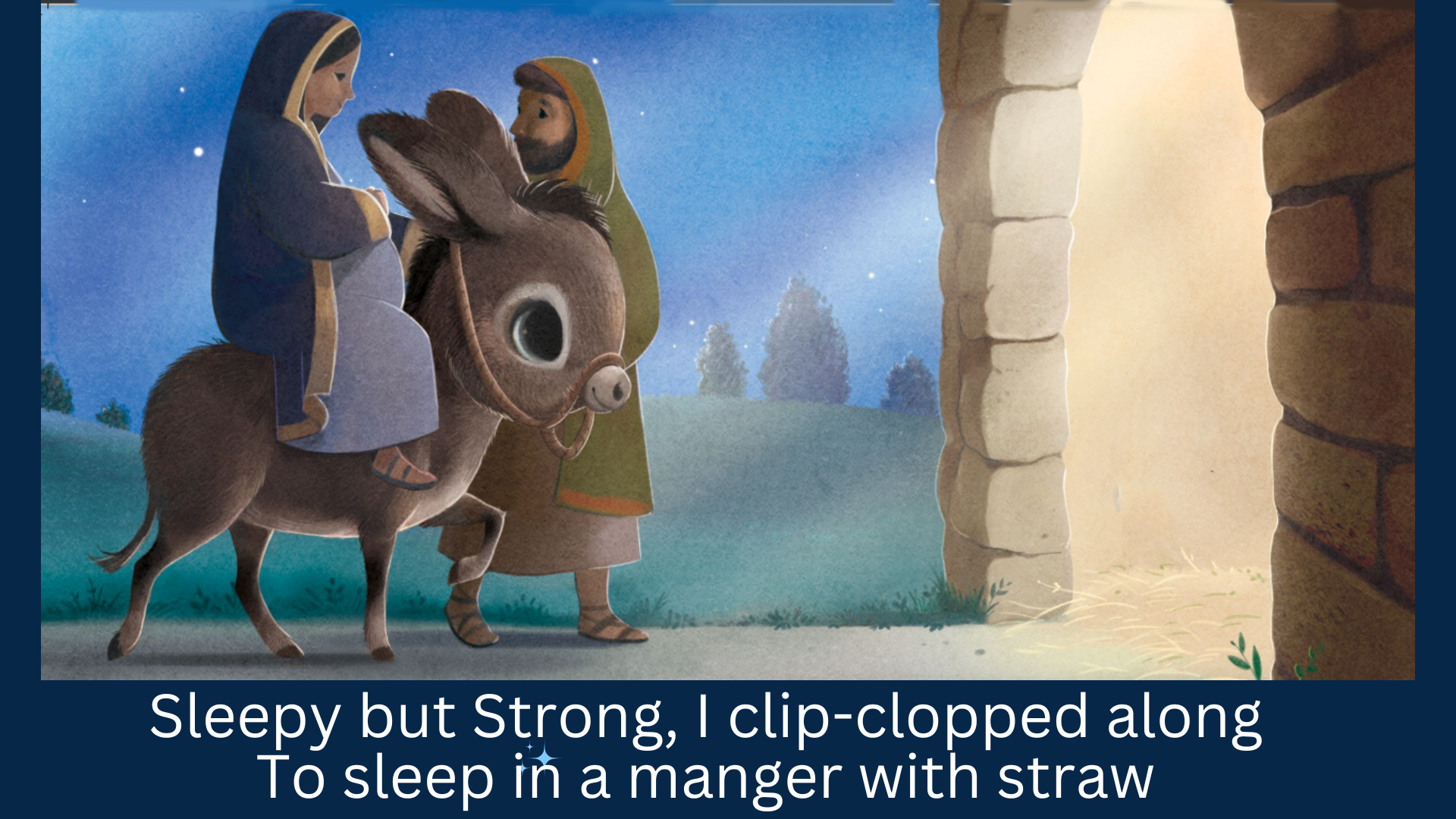
In her biography, Tomie dePaola His Art & His Stories, Barbara Elleman said the following about dePaola’s tendency to write about himself and about his family:
Autobiographical Tales
The Beginning of the 26 Fairmount Series
“His father, an ardent photographer and also a home-movie buff, rarely let a birthday party, summer picnic at a beach, Christmas festivith, or any family gathering go by without recording it on film. The great-grandparents, grandparents, parents, siblings, and other relatives who once so readily posed for the senior dePaola’s camera now inhabit his son’s stories, radiating warmth and believability.
“DePaola, the recipient of these family treasures, says that these old home movies provide him with laughs and memories; it is obvious they furnish inspirational grist for his ever-active, creative mind. … In Nana Upstairs & Downstairs, the progagonist’s father is seen in the background with a home movie camera;
in Tom
and in The Baby Sister, photographic-style drawings identify the characters;
in The Art Lesson, his photographer cousins make a cameo appearance; and in Flicks, a boy enjoys five ‘silent films’ at the local movie theater. In a more general manner, his father’s old movies reconnect dePaoloa with his past and act as a memory check for the background details that give such warm ambience to his illustrations. And while the artist has an acute recollection about events of his. childhood, viewing these [pg. 25] films and photos can’t help but solidify the relatives’ images as he works to capture their identities and likenesses in his artwork.
“Whatever the source, dePaola’s wonderful assortment of Irish and Italian relatives arrives on the page richly arrayed in costume. expression, and personality. Reading dePaoloa’s autobiographical books is akin to getting to know the family–some sadness and pain show through, but love abounds. He contends that turning his childhood joys and traumas into stories delivers a core of reality that children can relate to and allows himself, as the writer, the opportunity for fictional invention.”
“DePaola the child is, of course, the focus of these stories. Readers meet him most often as the character Tommy–althoughsometimes he appears under other moniers. Tommy had his debut in Nana in 1973; then after a sixteen-year absence, he returne in three titles (The Art Lesson, Tom, and The Baby Sister). In between, dePaola continued drawing upon his childhood experiences, veiling himself umder other character names. He is Bobby in Now One Foot, Now the Other; Joey in Watch Out for the Chicken Feet in Your Soup; Andy in Andy, That’s M Name; and Oliver in Oliver Button Is a Sissy.
“His return to using Tommy as a character name signifies, perhaps, an increased ease with his childhood self and a willingess to share that person directly with young readers. In offering children the opportunity to exerience his real-life situations, dePaola lets his own vulnerability surface. …
“While dePaola’s autobiographical stories focus on events, which pivot the stories’ action, the underlying emotional issues are what tug at the heart. Deceptively sinple, his books often contain layers of meanng. He deftly wraps the pleasure of an understanding teacher, the distressful death of a grandparent, the importance of a name, the arrival of a new sibling in the comfortaing cocoon of story. As these incidents unfold, young readers gain saisfaction from seeing the littlest (themselves) rising to face the adult world. At the same time. adults enjoy the stories from the vantage point of both the children they once were and the adults they have become.”Elleman, pgs. 25-26.
Books Other Than DePaola’s Officially Labeled Autobiographical Tales Were Autobiographical
Before I continue talking about the DePaola’s books that are officially considered to be autobiographical, I want to return to the following comment:
“His return to using Tommy as a character name signifies, perhaps, an increased ease with his childhood self….” Elleman, pg. 26.
In the above phrase, Elleman suggests that for years [perhaps forever], dePaola was not comfortable with himself. In another part of her biography of dePaola, Elleman addresses the fact that dePaola was gay years before he acknowledged that to the public. In yet another part of her biography, Elleman reported that Tomie felt that his older brother Joe was the family favorite. In Oliver Button is a Sissy, dePaola addresses the fact that he felt that he was an outsider–a sissy. In another part of her biography, Elleman tells the reader that he was into theater, song, and dance–and he always loved drawing, in lieu of the things that other boys enjoyed. Tomie dePaola was deeply religious. Early in his life, he lived in a monastery, and tried the monastic lifestyle. For all of these reasons, I wonder if dePaola considered himself to be a “Clown of God.”
In his book Olver Button Is a Sissy, dePaola shows Oliver [himself] as a child drawing. Behind the seated child, some of his art is tacked to the wall. Notice that the child has drawn a juggling clown:
Image Credit: Amazoniver
Oliver Button was published in 1979. DePaola’s book The Clown of God was published in 1978.
In 1964, the hit song “See the Funny Little Clown” was released. I was 14 at that time, and I identified with the lyrics: “He laughs on the outside and cries on the inside.” I readily admit that secretly, I have always felt like an outsider.
Tomie dePaola was born in 1934. When Goldsboro sang about a clown who cried inside, dePaola was 30. I feel quite sure that he also saw himself in that song, and I believe that his picture book was autobiographical.

I also believe that his book The Friendly Beasts was autobiographical. The story of that book follows the old carol “What can I give Him, small as I am….”
In his book The Baby Sister, dePaola shows himself making art to decorate his baby sister’s new room. The older people were painting the room and the furniture and stocking the nursery with clean diapers. What could the tiny Tommy do? He could make art for the new baby’s room.
This brings me to another point about dePaola’s beautiful picture book The Friendly Beasts: I personally was deeply touched by that book, and it was one of my inspirations for my own picture book The Donkey’s Song,
The carol The Friendly Beasts continues, “I said the Donkey, all shaggy and brown. I carried His mother to Bethlehem town,” and that lyric inspired the first page of The Donkey’s Song:
Although I did not realize it when I wrote it, I know now that The Donkey’s Song is autobiographical. In speaking to groups since my book was published, I have acknowledged that I am the little shaggy donkey who was allowed the gift of experiencing a miracle. I understand how all of dePaola’s books are probably autobiographical–if only a bit.
November is National Memoir Month, and during that month, I’ll launch an event: Harvest Your Past. I have done that before, but this year, I’ll add what I have learned about how dePaola harvested his own past to create his own incredible body of work–over 260 picture books.
Discover more from Jacki Kellum
Subscribe to get the latest posts sent to your email.